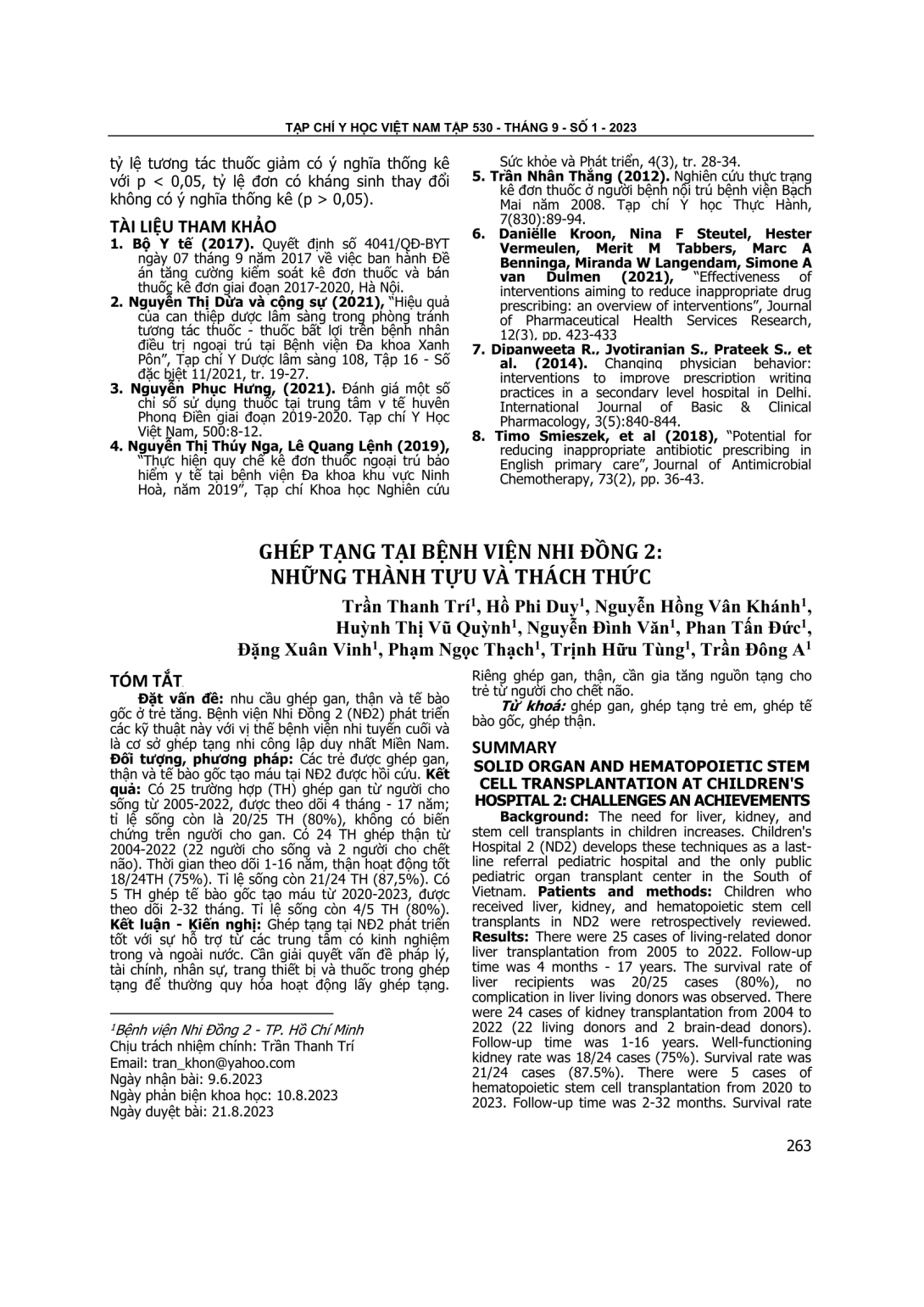
Nhu cầu ghép gan, thận và tế bào gốc ở trẻ tăng. Bệnh viện Nhi Đồng 2 (NĐ2) phát triển các kỹ thuật này với vị thế bệnh viện nhi tuyến cuối và là cơ sở ghép tạng nhi công lập duy nhất Miền Nam. Đối tượng, phương pháp: Các trẻ được ghép gan, thận và tế bào gốc tạo máu tại NĐ2 được hồi cứu. Kết quả: Có 25 trường hợp (TH) ghép gan từ người cho sống từ 2005-2022, được theo dõi 4 tháng - 17 năm; tỉ lệ sống còn là 20/25 TH (80%), không có biến chứng trên người cho gan. Có 24 TH ghép thận từ 2004-2022 (22 người cho sống và 2 người cho chết não). Thời gian theo dõi 1-16 năm, thận hoạt động tốt 18/24TH (75%). Tỉ lệ sống còn 21/24 TH (87,5%). Có 5 TH ghép tế bào gốc tạo máu từ 2020-2023, được theo dõi 2-32 tháng. Tỉ lệ sống còn 4/5 TH (80%). Kết luận - Kiến nghị: Ghép tạng tại NĐ2 phát triển tốt với sự hỗ trợ từ các trung tâm có kinh nghiệm trong và ngoài nước. Cần giải quyết vấn đề pháp lý, tài chính, nhân sự, trang thiết bị và thuốc trong ghép tạng để thường quy hóa hoạt động lấy ghép tạng. Riêng ghép gan, thận, cần gia tăng nguồn tạng cho trẻ từ người cho chết não
The need for liver, kidney, and stem cell transplants in children increases. Children's Hospital 2 (ND2) develops these techniques as a last-line referral pediatric hospital and the only public pediatric organ transplant center in the South of Vietnam. Patients and methods: Children who received liver, kidney, and hematopoietic stem cell transplants in ND2 were retrospectively reviewed. Results: There were 25 cases of living-related donor liver transplantation from 2005 to 2022. Follow-up time was 4 months - 17 years. The survival rate of liver recipients was 20/25 cases (80%), no complication in liver living donors was observed. There were 24 cases of kidney transplantation from 2004 to 2022 (22 living donors and 2 brain-dead donors). Follow-up time was 1-16 years. Well-functioning kidney rate was 18/24 cases (75%). Survival rate was 21/24 cases (87.5%). There were 5 cases of hematopoietic stem cell transplantation from 2020 to 2023. Follow-up time was 2-32 months. Survival rate was 4/5 cases (80%). Conclusion: Organ transplantation at ND2 was well-developed with support from experienced domestic and international centers. Existing obstacles including the lack of financial support, personnel shortages, and inadequacy in equipment, facilities and immunosuppressive drugs for organ transplants need to be addressed. As for liver and kidney transplants, it is necessary to increase the organ pool for children from brain-dead donors.
- Đăng nhập để gửi ý kiến
